Idiosepiidae
Pygmy squids
Katharina M. Mangold (1922-2003) and Richard E. Young- Idiosepius biserialis
- Idiosepius macrocheir
- Idiosepius mimus (?)
- Idiosepius notoides
- Idiosepius picteti
- Idiosepius paradoxus
- Idiosepius pygmaeus
- Idiosepius thailandicus
Introduction
This Idiosepiidae contains the smallest species within the Decapodiformes. Males in some species mature at lengths of 6 mm ML and females at 8 mm ML (Nesis, 1982/7). These cephalopods are elongate but have a rounded posterior mantle and separate fins. A unique attachment organ is present on the dorsal surface of the mantle which is used for attaching the animal to seaweed. They are found in shallow water in the Indo-West Pacific. An excelllent in situ video of a female Idiosepius sp. attaching to a blade of grass and then spawning can be seen here.
Brief diagnosis:
A decapodiform ...
- with an adhesive organ on the dorsal surface of the mantle.
Characteristics
- Arms
- Both arms IV hectocotylized.
- Arms with suckers in two series.
- Arm and tentacle suckers without circularis muscles.
- Tentacles
- Tentacles without carpal (= proximal) locking-apparatus.
- Tentacular clubs with suckers in 2 - 4 series.
- Head
- Head with tentacle pockets.
- Eyes with corneas.
- Funnel
- Funnel without lateral funnel adductors [are these muscles present but embedded in head tissue?].
- Funnel without lateral funnel adductors [are these muscles present but embedded in head tissue?].
- Mantle
- Adhesive organ on dorsal surface (see title drawing).
 Click on an image to view larger version & data in a new window
Click on an image to view larger version & data in a new window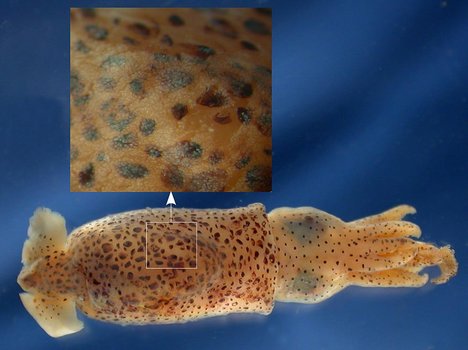
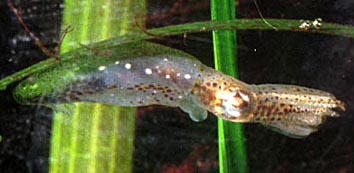
Figure. Top - Dorsal view of Idiosepius sp., preserved, with an enlargement of a portion of the dorsal adhesive organ showing the glandular (white reflection) epithelium. 12 mm ML, mature female, 05°27'S, 134°27'E. Photograph by R. Young. Bottom -Side view of Idiosepius paradoxus in an aquarium attached by its adhesive organ to a blade of seagrass. Photograph by Takashi Kasugai, Port of Nagoya Public Aquarium.
- Mantle not fused to head in nuchal region, but nuchal cartilage absent.
- Mantle locking-apparatus does not reach anterior mantle margin.
- Adhesive organ on dorsal surface (see title drawing).
- Fins
- Fins completely separate; with posterior lobes.
- Fins completely separate; with posterior lobes.
- Shell
- Shell a delicate gladius not reaching anterior or posterior ends of mantle.
- Shell a delicate gladius not reaching anterior or posterior ends of mantle.
- Viscera
- Right oviduct present but not functional.
- Accessory nidamental glands present.
- Gills without branchial canals.
- Eggs
- Eggs attach to substrate in flat masses.
Nomenclature
A list of all nominal genera and species in the Idiosepiidae can be found here. The list includes the current status and type species of all genera, the current status, type repository and type locality of all species and all pertinent references.
Life History
I. paradoxus spawns repeatedly in captivity. A single individual may lay as many as 42 batches over a 70 day period (Kasugai, 2006).
- Eggs
- Eggs attach to substrate in flat masses.
- Developing embryo has a large external yolk sac.
- Hatching occurs 16-18 days at 20°C (Yamamoto, 1988).

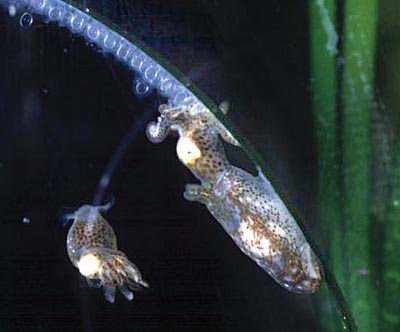
Figure. Side view of a spawning female I. paradoxus in an aquarium. The squid is attached to a blade of seagrass by its adhesive organ and is attaching its eggs to the underside of the same blade. Another I. paradoxus is swimming nearby, presumably a male. Photograph by Takashi Kasugai.
References
Kasugai, T. 2006. Spawning mode and reproductive output of the Japanese pygmy squid Idiosepius paradoxus (Cephalopoda: Idiosepiidae). Program and Abstract Book, CIAC '06, Hobart Tasmania.
Nesis, K. N. 1982. Abridged key to the cephalopod mollusks of the world's ocean. 385,ii pp. Light and Food Industry Publishing House, Moscow. (In Russian.). Translated into English by B. S. Levitov, ed. by L. A. Burgess (1987), Cephalopods of the world. T. F. H. Publications, Neptune City, NJ, 351pp.
Voss, G. L. 1963. Cephalopoda of the Philippine Islands. Bull. U. S. Nat. Mus., 234: 1-180.
Yamamoto, M. 1988. Normal embryonic stages of the pygmy cuttlefish, Idiosepius pygmaeus paradoxus Ortmann. Zoological Science, 5: 989-998.
Title Illustrations

| Scientific Name | Idiosepius notoides |
|---|---|
| Location | off Australia |
| Acknowledgements | provided by Mark Norman |
| Copyright | © 1996 David Paul |
About This Page
Katharina M. Mangold (1922-2003)

Laboratoire Arago, Banyuls-Sur-Mer, France
Richard E. Young

University of Hawaii, Honolulu, HI, USA
Page copyright © 2019 Katharina M. Mangold (1922-2003) and Richard E. Young
 Page: Tree of Life
Idiosepiidae . Pygmy squids.
Authored by
Katharina M. Mangold (1922-2003) and Richard E. Young.
The TEXT of this page is licensed under the
Creative Commons Attribution-NonCommercial License - Version 3.0. Note that images and other media
featured on this page are each governed by their own license, and they may or may not be available
for reuse. Click on an image or a media link to access the media data window, which provides the
relevant licensing information. For the general terms and conditions of ToL material reuse and
redistribution, please see the Tree of Life Copyright
Policies.
Page: Tree of Life
Idiosepiidae . Pygmy squids.
Authored by
Katharina M. Mangold (1922-2003) and Richard E. Young.
The TEXT of this page is licensed under the
Creative Commons Attribution-NonCommercial License - Version 3.0. Note that images and other media
featured on this page are each governed by their own license, and they may or may not be available
for reuse. Click on an image or a media link to access the media data window, which provides the
relevant licensing information. For the general terms and conditions of ToL material reuse and
redistribution, please see the Tree of Life Copyright
Policies.
- Content changed 31 October 2018
Citing this page:
Mangold (1922-2003), Katharina M. and Richard E. Young. 2018. Idiosepiidae . Pygmy squids. Version 31 October 2018 (under construction). http://tolweb.org/Idiosepiidae/19985/2018.10.31 in The Tree of Life Web Project, http://tolweb.org/




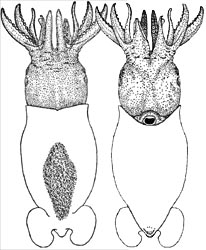
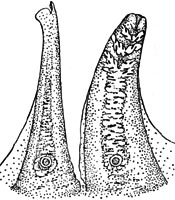



 Go to quick links
Go to quick search
Go to navigation for this section of the ToL site
Go to detailed links for the ToL site
Go to quick links
Go to quick search
Go to navigation for this section of the ToL site
Go to detailed links for the ToL site